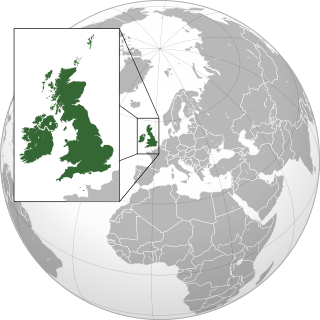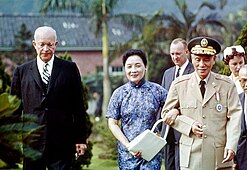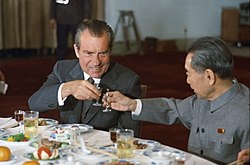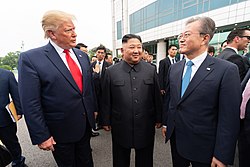
Camp David is a 125-acre (51 ha) country retreat for the president of the United States. It is located in the wooded hills of Catoctin Mountain Park, in Frederick County, Maryland, near the towns of Thurmont and Emmitsburg, about 62 miles (100 km) north-northwest of the national capital city of Washington, D.C. It is code named Naval Support Facility Thurmont. Technically a military installation, its staffing is primarily provided by the Seabees, Civil Engineer Corps (CEC), the United States Navy and the United States Marine Corps. Naval construction battalions are tasked with Camp David construction and send detachments as needed.

There have been 41 United States presidential visits to Canada by 14 presidents over the past century. As the U.S. president is both head of state and head of government, these visits have taken many forms, ranging from formal state visits to official visits, working visits, or private visits.
Fifteen presidents of the United States have made thirty-four presidential visits to Mexico. The first visit by an incumbent president to Mexico was made in 1909 by William Howard Taft. It was only the second time in U.S. history that a president left the country while in office.

On March 17, 2009, North Korean soldiers detained two American journalists, Euna Lee and Laura Ling, who were working for the U.S.-based independent television station Current TV, after they crossed into North Korea from China without a visa. They were found guilty of illegal entry and sentenced to twelve years' hard labor in June 2009. The North Korean leader Kim Jong Il pardoned the two on August 5, 2009, the day after the former U.S. president Bill Clinton arrived in the country on a publicly unannounced visit.
Ten United States presidents have made presidential visits to Eastern Europe and Northern Asia. The first trip by an incumbent president to Eastern Europe was made by Franklin D. Roosevelt in 1945, to the Soviet Union, and was an offshoot of Allied diplomatic interactions during World War II. The first trip by an incumbent president to Northern Asia was made by Gerald Ford in 1974, also to the Soviet Union, and was an offshoot of U.S.–Soviet Détente during the Cold War. The first presidential visits to other Eastern European countries occurred during this era of easing geo-political tensions as well.

Eleven United States presidents and three presidents-elect have made thirty-four presidential visits to Central America. The first visit by an incumbent president to a country in Central America was made in 1906 by Theodore Roosevelt. The trip, to Panama, was the first international presidential trip in U.S. history, and signaled the start of a new era in how presidents conducted diplomatic relations with other countries. In 1928, Herbert Hoover, during the time when he was president-elect, visited the region during his historic "good will" trip, to Central and South America.

Nine presidents of the United States have made presidential visits to North Africa. The first trips by a sitting president to countries in North Africa were those of Franklin D. Roosevelt, and were an offshoot of Allied diplomatic interactions during World War II. Of the five countries in the region, only Libya has not yet been visited by an American president.

Ten United States presidents have made presidential visits to the Middle East. The first trips by an incumbent president to countries in the Middle East were those by Franklin D. Roosevelt, and were an offshoot of Allied diplomatic interactions during World War II. To date, 16 visits have been made to Egypt, 12 to Saudi Arabia, 11 to Israel, six to both Iraq, Jordan and Turkey, four to Iran, three to the Palestinian Territories, two to both Kuwait and Syria, one to Bahrain, Georgia, Oman, Qatar, and to the United Arab Emirates. No incumbent American president has yet visited Armenia, Azerbaijan, Cyprus, Lebanon, and Yemen.

Eleven United States presidents and one president-elect have made presidential visits to South America. The first trip was made by Herbert Hoover in 1928. During this tour he delivered twenty-five speeches in ten Central and South American countries, almost all of which stressed his plans to reduce American political and military interference in Latin American affairs. In sum, he pledged that the United States would act as a "good neighbor."

There have been twenty-four United States presidential visits to Southeast Asia by ten U.S. presidents. Dwight D. Eisenhower became the first incumbent president to visit a Southeast Asian country when he visited the Philippines in 1960. Since then, every president, except John F. Kennedy and Jimmy Carter, has travelled to the region. The Philippines, a former U.S. colony (1902–1946) and a close U.S. ally, is the most visited Southeast Asian country with ten visits, followed by Indonesia with nine, and Vietnam with eight. Of the eleven sovereign states in the region, all but East Timor have been visited by a sitting American president.

Twelve United States presidents have made presidential visits to the United Kingdom and the Republic of Ireland. The first visit by an incumbent president to the United Kingdom was made in December 1918 by Woodrow Wilson, and was an offshoot of American diplomatic interactions with the Principal Allied Powers at the conclusion of World War I prior to the Paris Peace Conference. The first visit by an incumbent president to the island of Ireland was made in June 1963 by John F. Kennedy when he visited the Republic of Ireland. To date, 40 visits have been made to the United Kingdom and 11 to Ireland.

Eight presidents of the United States have made presidential visits to South Asia. The first trip by a sitting president to South Asia was by Dwight D. Eisenhower in 1959. Of the eight countries in the region, only 4 of them have been visited by a sitting American president: Afghanistan, Bangladesh, India and Pakistan. The other four countries, Bhutan, the Maldives, Nepal and Sri Lanka, have never been visited by a sitting American president.

Thirteen United States presidents have made presidential visits to Southern Europe. Woodrow Wilson became the first incumbent president to visit a Southern European country in January 1919 in the aftermath of World War I. Visits occurring during the 1940s through 1980s were offshoots of American diplomatic interactions during World War II and then the Cold War.

Thirteen United States presidents have made presidential visits to Western Europe. The first visits by an incumbent president to countries in Western Europe were made in 1918 and 19 by Woodrow Wilson in the aftermath of World War I. He was awarded the 1919 Nobel Peace Prize for his peacemaking efforts. Visits occurring during the 1940s through 1980s were offshoots of American diplomatic interactions following World War II and during the Cold War. To date, 40 visits have been made to France, 31 to Germany, 21 to Belgium, 11 to Switzerland, six to Austria, and five to the Netherlands. No president has yet visited Liechtenstein, Luxembourg or Monaco.

Seven United States presidents have made presidential visits to Northern Europe. Richard Nixon became the first incumbent president to visit a Northern European country when he went to Iceland in 1973. The first trips were an offshoot of the general easing of the geo-political tensions between the U.S. and the Soviet Union during the Cold War. To date, every nation in the region has been visited at least twice: Finland (7), Denmark (4), Latvia (3), Estonia (2), Iceland (2), Norway (2), Sweden (2), and Lithuania (2).

The post-presidency of Jimmy Carter began on January 20, 1981, following the end of Jimmy Carter's term as president. Carter was the 39th president of the United States, serving from 1977 to 1981. Carter's post-presidency is widely considered by historians and political analysts to be one of the most accomplished of any former U.S. president. After leaving office, Carter remained engaged in political and social projects, establishing the Carter Center, building his presidential library, teaching at Emory University in Atlanta, and writing numerous books, ranging from political memoirs to poetry. He also contributed to the expansion of the nonprofit housing organization Habitat for Humanity.


















